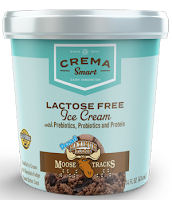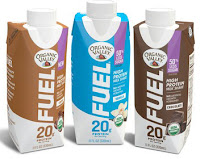That’s what Beckon ice cream is all about. The company wants to keep lactose-intolerant consumers buying real dairy ice cream.
“Beckon is here to welcome lactose-intolerant ice cream lovers back to real premium ice cream,” says Gwen Burlingame, co-founder. “We chose the name Beckon to illustrate that invitation or call to join in. Our ice cream is not an alternative; it’s the real deal. We’re extending deliciously creamy, dairy-full ice cream to an entire group of individuals who have previously had to compromise.”
Approximately 65% of the human population has a reduced ability to digest lactose, according to the National Institutes of Health. This is due to the lack of the enzyme lactase, which is responsible for breaking lactose down into the monosaccharides glucose and galactose. When lactose does not break down in the small intestine, it passes into the large intestine, where it may cause diarrhea, bloating and gas.
Beckon eliminates lactose by adding lactase to the milk during manufacturing. This is the most common and easiest approach to eliminating lactose from dairy foods. A side perk to this process is that glucose and galactose are sweeter than lactose, and in products such as flavored milk, ice cream and yogurt, an “added-sugar” reduction may be possible.
Lactose intolerance is most prevalent in people of East Asian descent. Its occurrence is lowest in populations where unfermented dairy products, namely fluid milk, are a staple. Only about 5% of Northern European descendants, for example, are lactose intolerant.
Regardless of ethnic heritage, after infancy, humans naturally start to produce less lactase. For a few, there’s significant loss, but most continue to produce varying amounts of lactase throughout life. A fair amount of the population produces enough lactase so that lactose-related intestinal discomforts are not experienced. The level of intolerance impacts the amount of lactose one can consume before experiencing painful side effects.

HP Hood produces the Lactaid brand of dairy products. Milk products have been fairing quite well for the brand. While retail sales of all fluid milk were down about 1% for the 52-week period ending August 11, 2019, according to IRI, Lactaid low-fat and skim milk sales were up 2.3% to $416.3 million, while Lactaid whole milk sales increased 11%, ringing in at $165.9 million. The brand can also be found on ice cream, cottage cheese and seasonal eggnog.
There clearly is a need for lactose-free milk, which is one of the least tolerated dairy foods by those with lactose sensitivities. That’s because lactose-intolerance symptoms typically occur when the load of lactose is very large and rapidly arrives in the large intestine. Fluid milk is the most concentrated source of lactose.
Most value-added milk brands now include lactose-free options. This includes milks that are organic and higher in protein, with the latter accomplished through either filtration or the addition of milk proteins.
Darigold, for example, now offers FIT, a lactose-free, high-protein milk. The farmer-owned co-op’s ultrafiltration process naturally concentrates protein and removes sugars. Lactase enzyme ensures the product is lactose free. FIT contains 75% more protein and 40% less sugar than regular 2% milk. A one-cup serving of 2% white contains 130 calories, 5 grams of fat, 7 grams of sugar (no added sugar) and 14 grams of protein. FIT Chocolate contains 170 calories, 5 grams of fat, 14 grams of sugar (8 grams are added) and 14 grams of protein.
JoeFroyo boldly touts the lactose-free quality of its ready-to-drink cold brew drinkable yogurt line and 100% real half-and-half. This is achieved through fermentation by the live and active probiotic cultures. The creamer also includes lactase.
The innovative Clean Label Creamer is infused with seven probiotic cultures and manufactured using high-pressure processing. The latter is a cold process that safely extends the refrigerated shelf life of fresh dairy cream without the use of damaging heat or preservatives.
The liquid creamer comes in ready-to-pour 32-ounce bottles, as well as half-gallon and gallon jugs. A 2-tablespoon serving contains 37 calories and 3 grams of fat. The Original variety will soon be joined by Toffee, Vanilla Cream and White Chocolate flavors. There’s also a dried version available in a 16-ounce shakers and single-serve packets.
JoeFroyo recently entered ice cream category with Crema Smart, which contains a nutritional boost of prebiotics, probiotics and protein. The ice cream is made with the same gently pasteurized milk that goes into JoeFroyo’s Functional Cold Brew. It includes chicory root, a prebiotic fiber, to fuel the effectiveness of the probiotics. The ice cream also features a proprietary natural dairy sweetener called Crema Sweet, which is hydrolyzed lactose, or simply glucose and galactose, which is sweeter than lactose. The company adds lactase to break down all remaining milk sugar.
“We believe milk is the original clean-label beverage and have taken an intelligent approach to improving dairy in our Crema Smart line of products, allowing people to return to real dairy without the discomfort of lactose,” says Zach Miller, founder.
Prairie Farms offers an array of lactose-free milks, with Lactose-Free Premium Chocolate Milk its most recent innovation. Under its North Star brand the company also offers lactose-free ice cream bars.
Powered by a variety of lactose-free real dairy milk options, Prairie Farms is challenging the notion that consumers must switch to almond or soy beverages in order to avoid digestive issues. When compared to those products, real milk sourced from cows offers the additional benefit of eight essential nutrients and vitamins including calcium, protein, vitamins A, D and potassium not found in water or plant-based alternatives.

“We frequently hear from consumers they would like to drink chocolate milk, but simply can’t because of their digestive issues,” says Rebecca Leinenbach, vice president of marketing and communications. “Prairie Farms listened and I’m happy to report that we can now offer them a great-tasting premium chocolate milk with no flavor compromises.”
“Prairie Farms’ dairy farmers and cows work extra hard to bring milk to consumers and our job is to find ways for everyone to enjoy it,” says Leinenbach. “Now everyone can benefit from the nutrition and great taste of Prairie Farms premium chocolate milk regardless of lactose intolerance.”
The highly creative team at Live Real Farms, a new brand owned and managed by Dairy Farmers of America, is rolling out Live Real Farms Dairy Plus Milk Blends. Using a unique blending process, Live Real Farms takes pure milk from 100% family-owned farms and blends it with either almonds or oats to create a new milk taste and texture with just the right amount of sweetness. The new beverage comes in five lactose-free varieties.
Organic Valley is rolling out new and improved Fuel high-protein milk shakes, which have 50% less sugar than before. The shelf-stable milk shake contains 20 grams of organic protein and comes in three flavors: Chocolate, Coffee and Vanilla. Fuel starts with USDA certified organic milk from the cooperative’s pasture-raised cows. During the ultra-filtering process, the naturally occurring lactose in the milk is reduced. The addition of a lactase enzyme makes Fuel lactose free.
The company also offers Organic Valley Ultra milk. It’s packed with 50% more organic protein and 50% less sugar than regular milk. The four lactose-free varieties are: Whole, 2% Reduced Fat, 2% Chocolate and Skim.

Lala has introduced flavored lactose-free, protein-packed milk to the Mexican marketplace. Lala 100 is the first milk brand in Mexico without lactose. It debuted in unflavored formats in 2016. The new flavored varieties are Chocolate and Vanilla. The company uses ultrafiltration to remove the lactose and concentrate the protein and calcium content. Lactase is added to ensure the product is lactose free. The perishable product is described as containing 70% more of natural milk proteins and 30% more calcium than regular milk.
Slate is a better-for-you shelf-stable chocolate milk intended for the adult palate. The lactose-free beverage comes in three varieties--Classic Chocolate, Dark Chocolate and Mocha Flip—all of which contain 75% less sugar and 50% more protein than regular chocolate milk. The brand Slate suggests reintroducing chocolate milk to consumers with a clean slate, with less sugar, no lactose and more protein. Monk fruit keeps sugar and calorie content low.
When children show digestive issues, one of the first things parents will often eliminate is dairy products because of the lactose. Therefore, it makes sense for kid-centric products to be designed to be lactose free.
That’s what you find in new Danone Wild Danimals, which comes in Berry Blast, Mango Mojo and Strawberry Smash flavors. A single-serve bottle is a good source of (6 grams) protein and (3 grams) fiber and an excellent source of calcium and vitamin D (20% of the Daily Value). Added lactase enzyme renders the beverage lactose free. It also helps keep added sugars at 9 grams while maintaining the sweetness kids appreciate.
Brownes Dairy is on board, too, with going lactose-free in new kids’ innovations. Wiggles yogurt pouches contain both prebiotics and probiotics and come in four kid-friendly flavors: Blueberry, Mango, Strawberry and Vanilla Bean. The yogurt is made from whole milk and natural fruit, and contains no added sugar, artificial colors or flavors, and is preservative free. The sweetness comes naturally from the fruit ingredients, along with assistance from the chicory root fiber and lactase.
Many cultured dairy products are already low in lactose, as the cultures ferment the lactose into lactic acid. However, many brands are taking extra steps to ensure a completely lactose free product.
Siggi’s, for example, has added lactose-free whole milk skyr to its Icelandic yogurt lineup. The product comes in Plain and Vanilla in 24-ounce tubs. Plain has 18 grams of protein and only 5 grams of sugar per serving, while Vanilla contains 17 grams of protein and only 11 grams of sugar per serving.
Green Valley Creamery offers an extensive range of lactose-free cultured dairy products, with Greek yogurt its most recent offering.The Greek yogurt claims to be the first-ever lactose-free Greek yogurt to hit the U.S. market. It's available now for national distribution. Product offerings include single-serve 5.3-ounce cups in four different flavors and multi-serve 32-ounce cups in Plain and Vanilla Bean.
“Lactose-free dairy is all we do,” says Rich Martin, managing director. “We are committed to serving this community, which means we do a lot of listening to our customers. Greek yogurt was at the top of the list for most-requested new items and we’re excited to be able to expand our offerings in this way.”
It makes sense for cultured dairy foods intended for digestive health to eliminate all traces of lactose to ensure the product is tummy friendly. Danone now has lactose-free options in its popular probiotic digestive health Activia yogurt line.
And, General Mills recently rolled out GoodBelly yogurts. A cup of GoodBelly Probiotics Lactose-Free Low Fat Yogurt provides one billion live and active probiotics of the strain BB-12. Each cup is packed with 11 grams of protein. And, you guessed it, lactase enzyme ensures the product is lactose free.
It’s time to go lactose free to reduce added sugars and keep dairy in the diet.



















No comments:
Post a Comment